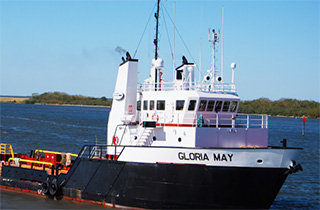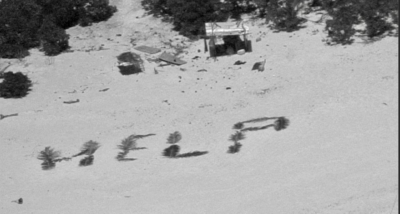Captains that were absorbed in their work and failed to keep proper lookout led to a 2014 collision in the Gulf of Mexico when an offshore service vessel that was heading back to base hit a commercial fishing vessel squarely amidships at 11.5 knots, according to a recently released report from the National Transportation Safety Board.
The 130’x36’x9’ OSV Gloria May, operated by Gulf Resource Management Inc., Galliano, La., was returning to the MOVK Base on Bayou Casotte near Pascagoula, Miss., when it crossed paths with the Capt Le, a 74’x22’x8’ shrimp boat registered in Irvington, Ala., at 10:40 p.m. on Aug. 24, 2014.
Working under contract to Chevron Energy, the Gloria May had delivered cargo and supplies to the 137’ liftboat Michael Eymard, which was supporting maintenance work on an oil platform located near Mobile Block 992 (MO-992), about 20 miles south of Pascagoula.
The OSV crew completed the unloading and securing deck cargo for the trip to shore around 10 p.m., according to a narrative in the NTSB report. Fifteen minutes later, one of the boat’s two captains was alone on the bridge and increased the vessel speed to 12.5 knots.
But after making a round of checks — including radar and visual lookout — the captain became distracted, NTSB and Coast Guard investigators found.
“At this time he did not detect any contacts ahead, either by radar or by sight,” according to the report. “About five minutes later, the second captain moved from the front of the bridge to the chart table, which was on the starboard aft side of the control station, and began filling out paperwork required for the voyage back to the MOVK Base.
“The second captain was alone on the bridge and diverted his attention from his primary duty to maintain a proper lookout.”
Meanwhile, the captain and two crewmen on the Capt Le had been steaming on parallel east-west tracks during the evening, looking for areas with the best rate of shrimp catch.
On the Gloria May, the second captain got up from his paperwork after about five minutes to make another round of checks. After a brief visit from a crewman in need of an electrical connector, the captain took another look around and observed bright deck lights from a nearby fishing vessel, off his starboard bow at a range of about two nautical miles.
“He also detected the vessel on radar; the port radar was set to the 6 nautical mile range, and the starboard radar was set to the 0.5 nautical mile range,” the report states. “The way the deck lights appeared to him, he believed the fishing vessel was headed away from him and did not pose a threat of collision.” With that evaluation, the captain returned to paperwork.
Around that same time, the master of the Capt Le executed another turn to go back on a westerly course. He told investigators he never saw the Gloria May on radar or visually.
The Gloria May captain noticed bright lights shining on his bridge, and ran for the throttle and steering controls. The OSV hit the shrimper on the port side, putting a 10-foot split in the hull between the engine room and fish hold.
Both crews quickly determined there were no serious injuries, and in about 20 minutes the fishermen were put off from the Capt Le in a liferaft and were taken on board the OSV.
The NTSB faulted both captains for failure to maintain adequate lookout. Under navigation rules, the Gloria May was burdened to give way for vessels engaged in fishing operations, but the Capt Le master shared responsibility, the report concluded.
“Although his night vision was severely degraded by the bright deck lights on his own vessel and his ability to maneuver was restricted by his deployed fishing nets, he should have maintained a proper lookout using all available means including visual, radar, and radio communications,” the report said.





